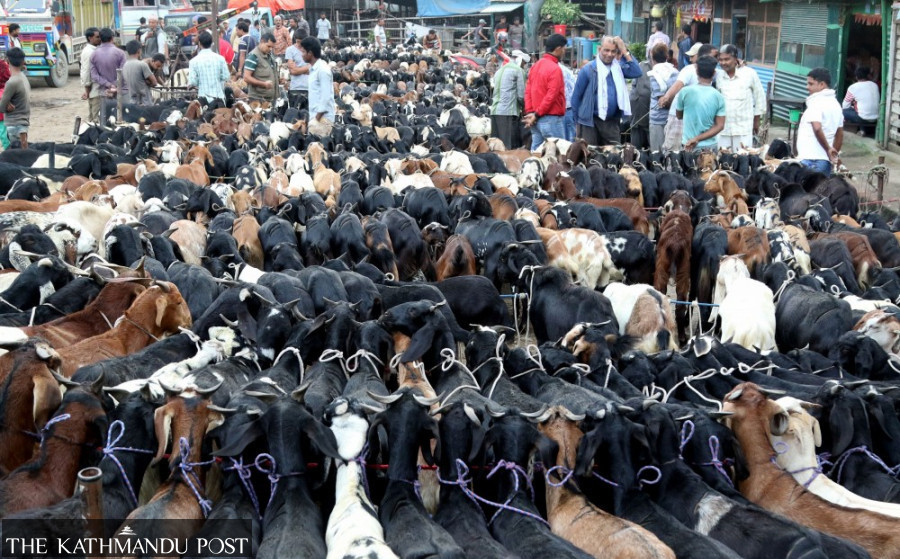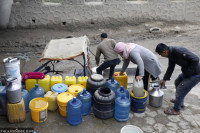Money
Goat prices may rise this Dashain despite the supply glut
The Department of Livestock Services estimates that around 100,000 goats are slaughtered in the Kathmandu valley during the Dashain festival.
Krishana Prasain
As the number of coronavirus cases recedes and the countdown for Dashain begins, Nepalis have been on a goat-buying frenzy for animal sacrifices and feasting.
Ghatasthapana, the first day of Dashain begins on Monday.
Traders said that the demand for live goats in the Kathmandu valley alone may rise significantly this Dashain.
The Department of Livestock Services estimates that around 100,000 goats are consumed in the Kathmandu valley during the Dashain festival.
Based on the average live goat price of Rs25,000 per head, the consumption, in value amounts to over Rs2.50 billion.
Private traders are supplying 70,000 goats while individual farmers may supply over 25,000 goats.
The state-owned Food Management and Trading Company also supplies 3,000 goats. But the company’s objective is to intervene in the market price.
Goats have already become a common sight in Kathmandu’s streets, indicating the arrival of the annual festival.
“This year, private traders may supply 70,000 goats in the Valley,” said Chandra Dhakal, senior livestock development officer at the Department of Livestock Services.
Around 55,000 goats were sold during last year’s Dashain, Dhakal said.
Heifer International Nepal has said that it can supply around 100,000 goats through different cooperatives, he added.
“Hence, the market will not see a shortage of goats.”
Mutton continues to be one of the major delicacies on the dining tables of Nepali consumers during Dashain as thousands of goats and livestock are slaughtered for feasting.
Increasing supplies, however, have not helped to trim goat prices during the booming festive period, traders say.
Jiban Raj Khatiwada, manager of Kathmandu Livestock Market, said they would supply 25,000 goats in the valley.
There are around a dozen goat suppliers in the valley alone.
Khatiwada said that the demand for goats is higher this Dashain as compared to last year’s festive season.
Khatiwada said that live goats might cost around Rs750 per kg, a rise of Rs100 per kg this year. “As the transportation cost has become high, the cost is adjusted in the meat price.”
The price may not get reduced despite the surplus of supply, he said.
The Food Management and Trading Company is supplying 3,000 goats and mountain goats in the valley.
The company sold 1,955 goats during Dashain last year.
Since the Chinese border closed due to the Covid-19 pandemic, mountain goats have not been imported for the past two years.
“We are expecting that around 1,500 mountain goats will be supplied for this Dashain,” Khatiwada said.
As most of the mountain goats come from China with very little domestic production, the price of it is expected to increase to more than Rs1,500 per kg.
The price of a live mountain goat was Rs1,200 per kg during last Dashain.
According to Khatiwada, a few mountain goats will start arriving on Monday while goats targeted for the Dashain sale will start arriving two weeks earlier than Phulpati which is on October 2.
The data from the Department of Customs show that the import of live goats increased by 321.51 percent in the last fiscal year.
The rise in imports was due to the low import base in the previous fiscal year as the country was in lockdown.
According to the Department of Customs, Nepal imported 50,787 live goats worth Rs454.73 million in the last fiscal year.
In the previous fiscal year, 2020-21, the country imported 13,827 live goats worth Rs107.88 million.
The country imports live goats mainly from India.
Khatiwada said 95 percent of goats will be supplied from the domestic market while the remaining 5 percent deficit will be met by imports from India.
“The price will remain unchanged this year due to a sufficient supply of goats in the market,” Dhakal said.
According to the department, there is a demand for 1,000 to 1,200 goats during normal time in the valley with the price hovering at Rs1,300 to Rs1,400 per kg.
In normal times, live goats cost Rs600 to Rs650 per kg.
There is a demand for 5 million goats annually in the country.
As per government data, a Nepali eats 18.1 kg of meat annually, well above the benchmark set by the Food and Agriculture Organisation (FAO).
Per capita meat consumption was 9.8 kg per year in 2008 and 9.7 kg in 2000.
According to the FAO, meat demand continues to increase as income levels keep on growing in developing countries, where per capita consumption is projected to rise further and per capita growth rates to be equivalent to those in the developed countries when compared to the base period.
The department will be conducting market monitoring from September 27 to October 4, according to government officials.




 7.12°C Kathmandu
7.12°C Kathmandu















